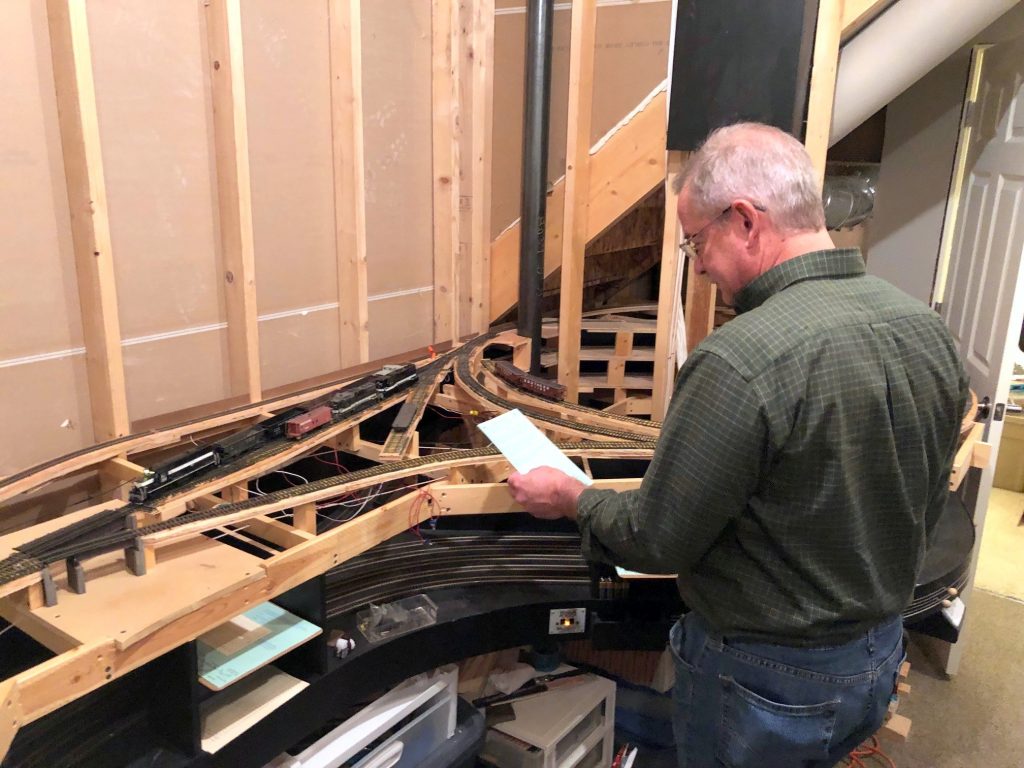
I’d like to thank Patrick Tillery for informing we he was coming over Monday night to check out progress on the layout which became the catalyst for the first multi-train operating session on the St Charles Branch! Despite some major obstacles such as having to reach under or across the layout to throw switches and a couple turnouts and cars that were acting up under their first real use, we managed to run 3 trains: the St Charles Local, the St Charles Switcher, and the L&N’s CV Local. These are the three primary trains on the layout during “busy times” across all eras of the layout–the timing of the trains may vary, but each serves the same basic function.
The St Charles Local is a scheduled train that runs between Appalachia/Andover, VA and St Charles. In leaner times, it serves as the mine run for the St Charles area branches. In heavier times, it serves to shuttle empty hoppers to the small “yard” at St Charles and pick up loads retrieved by the St Charles-based mine run. This is the “big train” on the layout and the only train to ever be assigned more than two locomotives.
The St Charles Switcher, known in some eras at the Black Mountain Local, is the mine run based out of St Charles that serves the area loaders. It picks up empties dropped off by the St Charles Local and plies the numerous branches and tipples dropping off empties and picking up loads. This train is the star of operations on the layout and the only train that will normally have a crew of two (conductor and engineer).

The L&N Cumberland Valley (CV) Local is the only other scheduled train on the layout. This train works the old L&N mainline between Corbin, KY and Appalachia, VA including the modest coal loadings of the Middlesboro, KY area mines and the St Charles Branch. The L&N has trackage rights over the portion of the St Charles Branch from L&N Junction (Pocket), VA to the ends of the branches beyond St Charles which it reached via a short L&N branch between Pocket, VA and the L&N’s CV mainline at Pennington, VA. Despite several loaders in this area, the prototype CV Local never seemed to need more than a single locomotive, an RS3 or a C420, to handle the handful of hopper loads bound for the L&N.
Last night’s operating session took about 2 real hours. Patrick took the first train, the L&N CV Local, up to Mayflower to swap out 4 empties for 5 loads. Leading the train was Alco C420 400 still in Tennessee Central colors (it’s bound for the paint shop soon, but the L&N used ex-TC C420s on this line because they were the lightest on the railroad). The CV Local had to first stop at the depot track on St Charles wye to pick up an extra set of orders from the Southern dispatcher. This job took about 40 minutes from start to finish. After the L&N CV Local cleared St Charles, the St Charles Switcher with me as engineer showed up with 18 cars – 16 empties, a covered hopper of fertilizer for Mayflower, and a boxcar for the team track at St Charles. It took about 20 minutes to assemble the loads from the previous day and replace them with the fresh cars in the tiny 3-track yard. A derailment kept the L&N CV Local waiting for a few minutes until the superior train on the timetable was finally able to depart for Appalachia.
With the home rails now to itself, the St Charles Switcher left the house track next to the depot to serve four tipples with Patrick as engineer and me as conductor. We worked the two local tipples first, JAD Turner and Cavalier, before swapping out the boxcar for a now empty flat on the team track. With the locals taken care of, we swapped roles and picked up the remaining empties an the load of fertilizer and headed up the branch to Mayflower. At Mayflower, it took two sets of run-around moves to place the empties above the tipple and swap out covered hoppers on the tail track. One more run-around set us up to work the stub track at Baker before assembling all the loads and departing town. A little blocking back at St Charles yard rounded out the job which took nearly an hour.
All told, we got 2 hours of operations out of just 1/2 the layout–not bad! Despite working out a few kinks in the rolling stock and trackwork, the overall track arrangements worked well for the jobs–they required enough moves to keep operators thinking and having to make smart moves without being frustrating for lack of sufficient track. I underestimated how handy it is to have a wye for turning trains working the yard instead of having to run around the length of the train. It was also the first major use of paperwork on the layout, something I’ll describe in more detail in a future article.
I’m so glad Patrick was up to playing guinea pig for the first session, and I’ve now got a new punch list of stuff I need to fix before attempting this again. All part of the learning process!
Exciting news that trains are out and about. Each accomplishment can serve as motivation for the next link in the chain. Keep killing it for those of us that live vicariously thru your achievements.